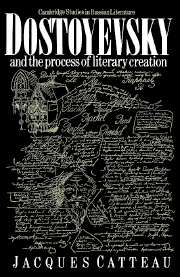Book contents
- Frontmatter
- Contents
- Preface to the English edition
- List of abbreviations
- General editor's note on transliteration and references
- General introduction
- PART I The creative environment
- PART II The process of creation
- Part III Time and space in the world of the novels
- Introduction
- 19 The master of men and hours
- 20 Chronology and temporality in The Idiot
- 21 The ascending spiral
- 22 Time of power and power of time
- 23 The havens of eternity
- 24 The dream of space and the space of the real
- 25 The inventory and the expressionist orchestration of scenery and lighting
- 26 The semantics of colour
- 27 The hero in space: sighting and seeing
- Conclusion
- Notes
- Select bibliography
- Index of names
21 - The ascending spiral
Published online by Cambridge University Press: 18 December 2009
- Frontmatter
- Contents
- Preface to the English edition
- List of abbreviations
- General editor's note on transliteration and references
- General introduction
- PART I The creative environment
- PART II The process of creation
- Part III Time and space in the world of the novels
- Introduction
- 19 The master of men and hours
- 20 Chronology and temporality in The Idiot
- 21 The ascending spiral
- 22 Time of power and power of time
- 23 The havens of eternity
- 24 The dream of space and the space of the real
- 25 The inventory and the expressionist orchestration of scenery and lighting
- 26 The semantics of colour
- 27 The hero in space: sighting and seeing
- Conclusion
- Notes
- Select bibliography
- Index of names
Summary
Her soul was mysteriously unable to bear the straight line and had mysterious yearnings for something more complicated.
F. M. Dostoyevsky, ‘Two suicides’, Diary of a Writer, 1876The sphere, the whirling ellipse, the spiral and all the dynamic forms which the infinite power of artistic genius will be able to discover.
C. D. Carrà, Futurist Manifesto (1913)The spiral curve of The Idiot
On first reading The Idiot, the dominant sensation is giddiness, trepidation, stress. The constraining dynamics of the action feels like an attack.
However, when we consider the novel as a whole, we find a strange parallel between the rhythm of the first two parts (first and second) and the last two (third and fourth), although there is noticeable break between them, since the last day of the second part is also the first day of the third. The two wholes thus formed both begin with a crescendo of great purity (one day in the first part, two nights in the third) and continue to alternate doubtful periods, or plateaus where chronicle time is dominant, with dramatic summits when the crisis explodes.
The repetition of figures accentuates this impression of parallelism. Myshkin has two epileptic fits, Nastasya Filippovna directs two libels against Yevgeniy Pavlovich, Ippolit makes two proclamations, one oral, the other read from a script. Nastasya runs off twice with Rogozhin into the night, there are two strange wanderings by Rogozhin and Myshkin through the streets of Petersburg, two meetings fixed by Aglaya on the green bench (first with Myshkin, then with Ganya), two chivalrous interventions by Myshkin to protect women, and both with fairly painful results, Ganya's slap and the officer's blow on the chest.
Information
- Type
- Chapter
- Information
- Dostoyevsky and the Process of Literary Creation , pp. 354 - 362Publisher: Cambridge University PressPrint publication year: 1989
